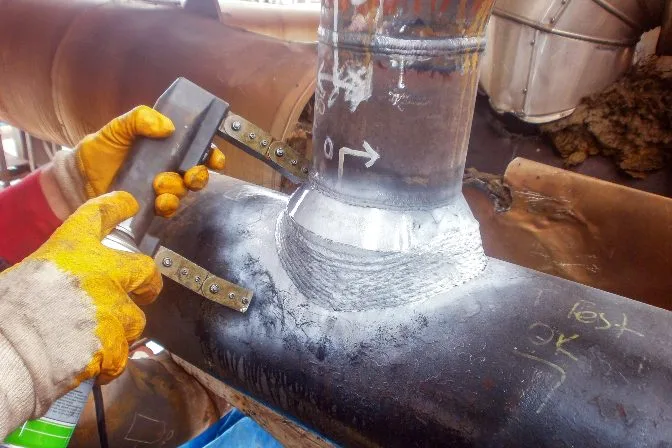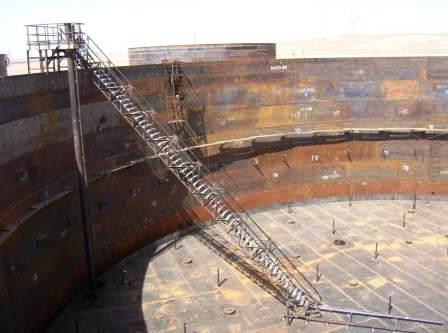Exactly How to Ensure Compliance with Tank Welding Inspection Requirements
Exactly How to Ensure Compliance with Tank Welding Inspection Requirements
Blog Article
An In-depth Overview of Storage Tank Welding Evaluation Standards and Methodologies for Improved Weld Quality and Performance
The significance of welding examination criteria in the manufacturing of storage tanks can not be overstated, as they offer as the backbone for ensuring weld honesty and operational reliability. Different inspection techniques, consisting of aesthetic assessments and progressed non-destructive testing methods, are crucial in identifying potential flaws that might endanger performance.
Importance of Welding Assessment Criteria

Welding evaluation standards encompass a variety of criteria, including product specs, welding treatments, and certifications of workers involved in the welding process. By enforcing these requirements, companies can systematically identify and rectify potential issues, consequently reducing the likelihood of expensive fixings or catastrophic failings. In addition, rigorous evaluation techniques foster a culture of liability and precision, encouraging welders to preserve high levels of workmanship.

Common Welding Examination Strategies


Ultrasonic Evaluating (UT) is another prevalent strategy, making use of high-frequency audio waves to detect inner defects that might not show up on the surface. This technique is particularly effective for recognizing spaces or incorporations within the weld steel. Magnetic Bit Checking (MT) is likewise widely made use of, particularly for ferromagnetic products, as it exposes surface area and near-surface problems via the application of magnetic fields and ferrous bits.
In Addition, Liquid Penetrant Screening (PT) finds surface-breaking problems by applying a penetrant to the weld and afterwards utilizing a designer to draw out the penetrant. Each of these methods adds to a detailed examination technique, making sure that welds fulfill the stringent top quality standards needed in tank building and construction.
Regulative Specifications and Conformity
Regulatory requirements and conformity are necessary components in making certain the security and reliability of bonded structures in container construction - Tank Welding Inspection. These requirements serve to establish minimum demands for product properties, welding procedures, and inspection practices, thereby reducing the threat of architectural failings and enhancing general performance
Secret organizations, such as the American Culture of Mechanical Designers (ASME) and the American Welding Society (AWS), offer guidelines that are extensively embraced in the market. Compliance with these standards not only makes sure adherence to ideal techniques but additionally satisfies legal and contractual responsibilities, guarding the rate of interests of stakeholders.
Governing bodies often mandate adherence to certain codes, such as ASME Code Section IX for welding qualifications and API 650 for welded containers. These codes detail requirements for welding methods, qualifications of personnel, and testing approaches to verify weld stability.
Regular audits and More Bonuses examinations are important to keeping compliance, as they assist determine discrepancies from developed requirements. Non-compliance can result in considerable charges, job hold-ups, and safety threats. Thus, a robust understanding of governing criteria and a dedication to compliance are paramount in attaining high-quality and long lasting welded container frameworks.
Non-Destructive Examining Approaches
How can the honesty of welded frameworks be guaranteed without causing damages? Non-destructive screening (NDT) techniques look at this site offer a robust service, enabling inspectors to evaluate weld quality without compromising the product - Tank Welding Inspection. Among one of the most common NDT methods are ultrasonic testing (UT), radiographic testing (RT), magnetic bit screening (MT), and dye penetrant screening (PT)
Ultrasonic screening uses high-frequency acoustic waves to discover internal flaws and define product properties. It provides exact dimensions and is specifically efficient for thick products. Radiographic testing involves passing X-rays or gamma rays through the weld, producing pictures that reveal architectural issues such as cracks or gaps. This approach is indispensable for analyzing the stability of complicated welds.
Magnetic particle testing is matched for ferromagnetic materials, where magnetic areas expose surface area and near-surface suspensions. Color penetrant testing utilizes a fluid color to highlight surface-breaking imperfections, making it a reliable technique for non-porous materials.
Each of these NDT approaches has distinct advantages, permitting detailed analyses tailored to details materials and welding procedures. By carrying out these techniques, industries can make sure the reliability and safety and security of bonded structures, inevitably boosting general performance.
Enhancing Weld Top Quality With Evaluation
Efficient evaluation plays a critical duty in improving weld high quality, functioning as a vital checkpoint in the construction process. By recognizing prospective flaws early, assessments minimize the threat of compromised architectural integrity and make sure compliance with sector criteria. Utilizing a mix of visual evaluations, non-destructive screening (NDT) methods, and mechanical you could look here analyses, assessors can spot issues such as porosity, splits, and insufficient blend.
Applying a robust evaluation method not only boosts the overall top quality of welds but likewise cultivates a society of liability among welders and makers. Normal training and accreditation of inspection employees make certain that they are geared up with the needed skills to identify and address possible troubles effectively. This positive strategy minimizes rework and associated expenses, ultimately adding to project performance.
Additionally, comprehensive documentation of assessment searchings for offers important insights into reoccuring problems, promoting constant renovation in welding techniques. By leveraging sophisticated technologies, such as automated ultrasonic screening or digital radiography, weld top quality can be enhanced via much more accurate assessments. In conclusion, an extensive inspection procedure is vital in attaining high-grade welds, making sure safety, reliability, and longevity in container construction.
Final Thought
Finally, the execution of strenuous container welding inspection standards and approaches is vital for ensuring weld honesty and performance. By using a mix of visual inspections, non-destructive screening approaches, and adherence to regulative criteria, organizations can effectively identify and reduce prospective defects. Fostering a society of liability among welders additionally boosts the high quality of welding processes. Eventually, these techniques contribute to lowered architectural failures, lower repair work expenses, and enhanced operational efficiency within the sector.
Report this page